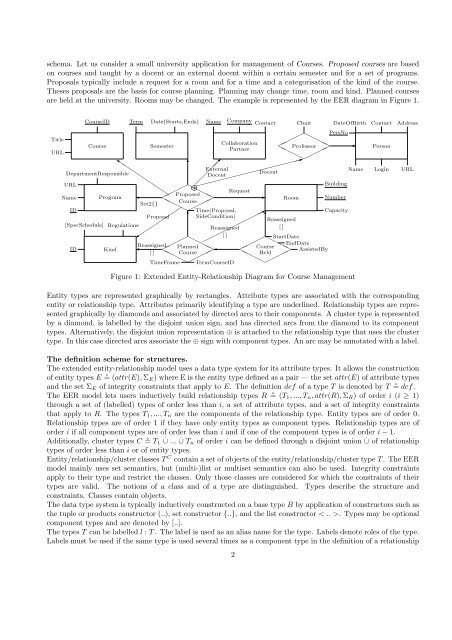BPMN and Beyond Business process modelling notation, workflow ...
BPMN and Beyond Business process modelling notation, workflow ...
BPMN and Beyond Business process modelling notation, workflow ...
Create successful ePaper yourself
Turn your PDF publications into a flip-book with our unique Google optimized e-Paper software.
schema. Let us consider a small university application for management of Courses. Proposed courses are based<br />
on courses <strong>and</strong> taught by a docent or an external docent within a certain semester <strong>and</strong> for a set of programs.<br />
Proposals typically include a request for a room <strong>and</strong> for a time <strong>and</strong> a categorisation of the kind of the course.<br />
Theses proposals are the basis for course planning. Planning may change time, room <strong>and</strong> kind. Planned courses<br />
are held at the university. Rooms may be changed. The example is represented by the EER diagram in Figure 1.<br />
Title<br />
URL<br />
ID<br />
CourseID<br />
Course<br />
DepartmentResponsible<br />
URL<br />
Name<br />
Kind<br />
Term<br />
[SpecSchedule] Regulations<br />
ID<br />
Program<br />
Date(Starts,Ends)<br />
Name Company Contact Chair<br />
✟<br />
✟<br />
✟✟ Professor<br />
Collaboration<br />
Partner<br />
Semester<br />
❍❍<br />
❍<br />
◗❦<br />
✻<br />
External<br />
Docent<br />
✒<br />
Docent ✘✘✘✘✘✘✘✘ ✘✿<br />
◗<br />
◗<br />
◗<br />
✟<br />
✟❍ L✘✘ ✘ ✘<br />
◗<br />
✘ ◗ ❍❍<br />
✛<br />
◗<br />
Request<br />
✟✟ Proposed ❍<br />
Room<br />
❍❍ Course<br />
❍✟ ✟✟ ✟<br />
✲<br />
Set2{} ❍<br />
✑ Time(Proposal,<br />
Proposal ✑ ✻<br />
✟✯<br />
SideCondition) ✻<br />
✑<br />
Reassigned<br />
✑<br />
Reassigned<br />
[ ]<br />
✑<br />
✑✰ ✟<br />
✟<br />
✟❍StartDate<br />
✟<br />
❍ [ ]<br />
❍❍ ✟ ✟✟✟✟✟✟✟ ❍❍<br />
✛Reassigned✟✟<br />
Planned ❍✛<br />
✟✟ Course ❍<br />
[ ] ❍❍ Course<br />
❍❍ Held<br />
❍✟ ✟✟ ✟<br />
❍<br />
❍✟ ✟✟ ✟<br />
❍<br />
TimeFrame<br />
TermCourseID<br />
❍ ❍❍<br />
❍<br />
❍✟ ✟✟ ✟<br />
EndDate<br />
AssistedBy<br />
DateOfBirth<br />
PersNo<br />
Building<br />
Number<br />
Capacity<br />
Figure 1: Extended Entity-Relationship Diagram for Course Management<br />
✲<br />
Name<br />
Contact<br />
Person<br />
Login<br />
Address<br />
URL<br />
Entity types are represented graphically by rectangles. Attribute types are associated with the corresponding<br />
entity or relationship type. Attributes primarily identifying a type are underlined. Relationship types are represented<br />
graphically by diamonds <strong>and</strong> associated by directed arcs to their components. A cluster type is represented<br />
by a diamond, is labelled by the disjoint union sign, <strong>and</strong> has directed arcs from the diamond to its component<br />
types. Alternatively, the disjoint union representation ⊕ is attached to the relationship type that uses the cluster<br />
type. In this case directed arcs associate the ⊕ sign with component types. An arc may be annotated with a label.<br />
The definition scheme for structures.<br />
The extended entity-relationship model uses a data type system for its attribute types. It allows the construction<br />
of entity types E ⊜ (attr(E), Σ E ) where E is the entity type defined as a pair — the set attr(E) of attribute types<br />
<strong>and</strong> the set Σ E of integrity constraints that apply to E. The definition def of a type T is denoted by T ⊜ def.<br />
The EER model lets users inductively build relationship types R ⊜ (T 1 , ..., T n , attr(R), Σ R ) of order i (i ≥ 1)<br />
through a set of (labelled) types of order less than i, a set of attribute types, <strong>and</strong> a set of integrity constraints<br />
that apply to R. The types T 1 , ..., T n are the components of the relationship type. Entity types are of order 0.<br />
Relationship types are of order 1 if they have only entity types as component types. Relationship types are of<br />
order i if all component types are of order less than i <strong>and</strong> if one of the component types is of order i − 1.<br />
. .<br />
Additionally, cluster types C ⊜ T 1 ∪ ... ∪ Tn of order i can be defined through a disjoint union ∪ . of relationship<br />
types of order less than i or of entity types.<br />
Entity/relationship/cluster classes T C contain a set of objects of the entity/relationship/cluster type T . The EER<br />
model mainly uses set semantics, but (multi-)list or multiset semantics can also be used. Integrity constraints<br />
apply to their type <strong>and</strong> restrict the classes. Only those classes are considered for which the constraints of their<br />
types are valid. The notions of a class <strong>and</strong> of a type are distinguished. Types describe the structure <strong>and</strong><br />
constraints. Classes contain objects.<br />
The data type system is typically inductively constructed on a base type B by application of constructors such as<br />
the tuple or products constructor (..), set constructor {..}, <strong>and</strong> the list constructor < .. >. Types may be optional<br />
component types <strong>and</strong> are denoted by [..].<br />
The types T can be labelled l : T . The label is used as an alias name for the type. Labels denote roles of the type.<br />
Labels must be used if the same type is used several times as a component type in the definition of a relationship<br />
2
















